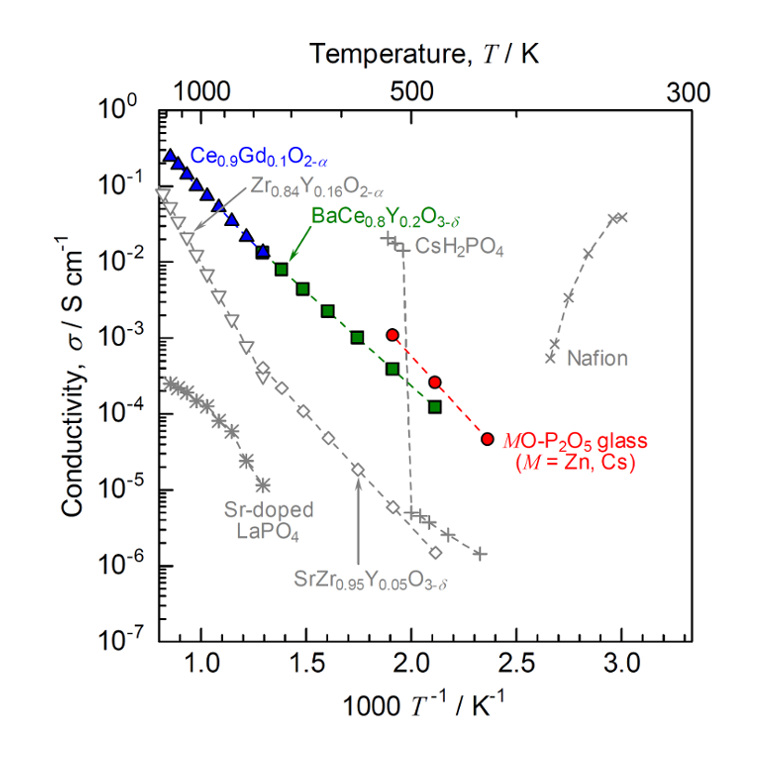|
1. Development of direct hydrocarbon utilization on solid oxide fuel cells (SOFCs)
炭化水素直接利用固体酸化物形燃料電池(SOFC)の開発
|
A fuel cell can generate electric power by an electrochemical reaction of hydrogen and oxygen, which is a inverse reaction of water electrolysis.
In principle, a solid oxide fuel cell (SOFC) can use not only hydrogen but also hydrocarbon fuels, because oxide ions (O2-) are conducted in an electrolyte of SOFC (Fig. a).
However, power cannot be generated for a conventional nickel-yttria stabilized zirconia (Ni-YSZ) anode, after liquefied petroleum gas (LPG) is supplied directly for 3 hours (Fig. b).
After power generation at 610 ºC, a large amount of carbon is deposited on the Ni-YSZ anode (Fig. c).
We have found that direct LPG utilization is possible for more than 24 hours using a nickel-gadolinia doped ceria (Ni-GDC) anode, which prevents carbon deposition (Fig. d).
On the other hand, carbon is deposited at high temperatures above 650 ºC for LPG and ethanol fuels.
Continuous power generation with internal partial oxidation reforming of butane and steam reforming of ethanol for 100 h is successful without carbon deposition at O/C = 1.5 and S/C = 2.0, respectively,
whereas the Ni-GDC anode deteriorates by carbon deposition at O/C = 1.0 in butane and at S/C ≤ 1.5 in ethanol (Figs. e, f and g).
|
燃料電池は水の電気分解の逆反応で、水素と酸素が電気化学的に反応すると発電することができます。
固体酸化物形燃料電池(SOFC)は、電解質内を酸化物イオン(O2-)が動くため(図a)、原理的に水素以外の燃料を用いることができます。
しかし、610 ºCで液化石油ガス(LPG)を直接利用すると、従来の負極であるニッケル−イットリア安定化ジルコニア(Ni-YSZ)では約3時間で発電不能になり(図b)、
発電後の負極上には大量の炭素が析出していました(図c)。
本研究では、ニッケル−ガドリニア添加セリア(Ni-GDC)を負極に用いることによって、24時間以上のLPG直接利用が可能であり、
負極上での炭素析出が抑制されることを見出しました(図d)。
一方、650 ºC以上の高温でLPGやエタノールを利用すると、炭素が再び析出してしまいます。
ブタン部分酸化改質O/C = 1.0およびエタノール水蒸気改質S/C ≤ 1.5の条件でNi-GDC電極は炭素析出によって劣化しますが、
ブタンO/C = 1.5およびエタノールS/C = 2.0の条件で100時間の内部改質連続発電に成功しました(図e, f, g)。
|

|
【主要論文】
H. Sumi, T. Yamaguchi, K. Hamamoto, T. Suzuki and Y. Fujishiro, "Impact of Direct Butane Microtubular Solid Oxide Fuel Cells", J. Power Sources, 220 (2012) 74-78.
http://dx.doi.org/10.1016/j.jpowsour.2012.07.106
H. Sumi, T. Yamaguchi, H. Shimada, Y. Fujishiro and M. Awano, "Internal Partial Oxidation Reforming of Butane and Steam Reforming of Ethanol for Anode-supported Microtubular Solid Oxide Fuel Cells", Fuel Cells, 17 (2017) 875-881.
http://doi.org/10.1002/fuce.201700154
|
2. Investigation of steam/CO2 co-electrolysis solid oxide electrolysis cells (SOECs) for achieving a carbon-neutral society
カーボンニュートラル社会の実現に向けた水蒸気−CO2共電解固体酸化物電解セル(SOEC)に関する研究
|
Solid oxide cells can be used as electrolyzers via the inverse reaction of fuel cells.
Solid oxide electrolysis cells (SOECs) can produce carbon monoxide (CO) from carbon dioxide (CO2) in addition to hydrogen (H2) from steam using renewable energy sources such as solar and wind power (Fig. a and b).
As a result of quantitative analysis using gas chromatography, the H2/CO ratios of the product gases are identical to the H2O/CO2 ratios of the input gases during steam/CO2 co-electrolysis (Fig. c).
Syngas (H2+CO mixture) can be converted into methanol (MeOH) in addition to e-fuel such as gasoline, kerosene, and diesel via Fischer-Tropsch synthesis.
MeOH becomes fuels for internal reforming SOFCs (Fig. d) in addition to raw materials for commodity plastics (e-chemical).
The co-electrolysis SOECs and the internal reforming SOFCs contribute to achieving a carbon-neutral society (Fig. e).
|
固体酸化物形セルは燃料電池の逆反応で電解にも使えます。
固体酸化物形電解セル(SOEC)は、太陽光や風力などの再生可能エネルギーを用いて、水蒸気から水素だけでなく、二酸化炭素から一酸化炭素を作ることができます(図a, b)。
ガスクロマトグラフィーを用いた定量分析の結果、水蒸気/CO2共電解時の生成ガスのH2/CO比は、供給ガスのH2O/CO2比と同じでした(図c)。
水素と一酸化炭素から成る合成ガスは、フィッシャー・トロプシュ法によってガソリンや灯油、軽油などの合成燃料(e-fuel)の他、メタノールにも変換できます。
メタノールは汎用プラスチック(e-chemical)の原料の他、SOFCの燃料にもなります(図d)。
共電解SOECと内部改質SOFCは、カーボンニュートラル社会の実現に貢献します(図e)。
|

|
【主要論文】
H. Sumi,"Co-electrolysis SOEC and Internal Reforming SOFC for Achieving a Carbon-neutral Society", RSC Sustain., 2 (2024) 1568-1579.
https://doi.org/10.1039/D4SU00095A
|
3. Advancement of electrochemical impedance analysis by distribution of relaxation times (DRT) method for SOFCs
SOFCにおける緩和時間分布(DRT)法による電気化学インピーダンス解析の高度化
|
Performance degradation (e.g. voltage drop) sometimes occurs for electrochemical devices such as fuel cells and secondary batteies (Fig. a).
AC impedance method is one of the analyses of internal electrical resistance for these cells.
The polarization resistance of a rate-determining electrochemical reaction can be separated by an analysis of phase sift under an application of AC voltage (current).
However, it is difficult to separate the resistance exactly for a solid oxide fuel cell (SOFC), because several reactions are generally overlapped in an AC impedance spectrum (Fig. b).
We successfully separate the anode and cathode resistances for microtubular SOFCs by the distribution of relaxation times (DRT) analysis with reference to the papers written by Prof. Ivers-Tiffée group (Karlsruher Institut für Technologie) (Fig. c).
The investigation of degradation mechanism is expected using this method (Fig. d).
The DRT analysis is a useful tool for the improvement of electrode performance and durability, so we investigate how to apply it to several types of electrochemical devices.
|
燃料電池や二次電池などの電気化学デバイスにおいて、電圧低下などの性能劣化が起こることがあります(図a)。
内部抵抗を解析する手法の一つに、交流インピーダンス法があります。
交流電圧(電流)を加えた時の位相遅れを解析することにより、律速過程となる電気化学反応の分極抵抗を分離することができます。
しかし、固体酸化物形燃料電池(SOFC)では、複数の律速過程がオーバーラップして観測されてしまうため、正確に抵抗分離することが困難です(図b)。
本研究では、Prof. Ivers-Tiffée (Karlsruher Institut für Technologie) グループの研究成果を参考にし、
緩和時間分布(DRT)法を適用することによって、マイクロチューブSOFCの正極・負極の抵抗を分離することに成功しました(図c)。
これにより、劣化メカニズムの解明などが期待されます(図d)。
電極高性能化や耐久性向上に向けて有用なツールであり、様々な電池への適用について検討しています。
【Note】Impedance & DRTのページに解説を掲載しました。
|

|
【主要論文】
H. Sumi, T. Yamaguchi, K. Hamamoto, T. Suzuki, Y. Fujishiro, T. Matsui and K. Eguchi "AC Impedance Characteristics for Anode-supported Microtubular Solid Oxide Fuel Cells", Electrochim Acta, 67 (2012) 159-165.
http://dx.doi.org/10.1016/j.electacta.2012.02.021
H. Sumi, H. Shimada, Y. Yamaguchi, T. Yamaguchi and Y. Fujishiro, "Degradation Evaluation by Distribution of Relaxation Times Analysis for Microtubular Solid Oxide Fuel Cells", Electrochim. Acta, 339 (2020) 135913.
http://doi.org/10.1016/j.electacta.2020.135913
|
4. Study on application of new electrolyte materials to intermediate temperature fuel cells
中温作動燃料電池への新規電解質材料の適用に関する研究
|
Perfluorinated polymer membranes (such as Nafion) and yttria-stabilizaed zironica (YSZ) are used as electrolytes for a polymer electrolyte fuel cell (PEFC) and solid oxide fuel cell (SOFC), respectively.
However, the conductiviities of Nafion and YSZ decrease by less than 10-2 S/cm at above 100 ºC and below 800 ºC, respectively.
In fundamental studies, we focus on new electrolyte materials such as Gd-doped ceria, Y-doped cerate and Cs/Zn-doped phosphate glasses to realize intermediate temperature (150-600 ºC) fuel cells with trial manufacturing of actual cells with electrodes.
|
現在実用化されている固体高分子形燃料電池(PEFC)ではNafionなどのフッ素系高分子膜が、固体酸化物形燃料電池(SOFC)ではイットリア安定化ジルコニア(YSZ)が電解質として用いられています。
しかし、Nafionは100 ºC以上で、YSZは800 ºC以下でイオン導電率が10-2 S/cm以下になってしまいます。
本研究では、ガドリニア添加セリア(GDC)やイットリア添加バリウムセレート(BCY),セシウム・亜鉛添加リン酸塩ガラス(MO-P2O5)などの新規電解質材料に着目し、
電極と組み合わせた燃料電池を実際に試作し、中温(150-600 ºC)作動化に向けた基礎的検討を行っています。
|

|
【主要論文】
H. Sumi, Y. Nakano, Y. Fujishiro and T. Kasuga, "Proton Conductivities and Structures of BaO-ZnO-P2O5 Glasses in the Ultraphosphate Region for Intermediate Temperature Fuel Cells", Int. J. Hydrogen Energy, 38 (2013) 15354-15360.
http://dx.doi.org/10.1016/j.ijhydene.2013.09.087
H. Sumi, E. Suda and M. Mori, "Blocking Layer for Prevention of Current Leakage for Reversible Solid Oxide Fuel Cells and Electrolysis Cells with Ceria-based Electrolyte", Int. J. Hydrogen Energy, 42 (2017) 4449-4455.
http://dx.doi.org/10.1016/j.ijhydene.2016.09.176
H. Sumi, H. Shimada, K. Watanabe, Y. Yamaguchi, K. Nomura, Y. Mizutani and Y. Okuyama, "External Current Dependence of Polarization Resistances for Reversible Solid Oxide and Protonic Ceramic Cells with Current Leakage", ACS Appl. Energy Mater., 6 (2023) 1853-1861.
https://doi.org/10.1021/acsaem.2c03733
|
|
![]()